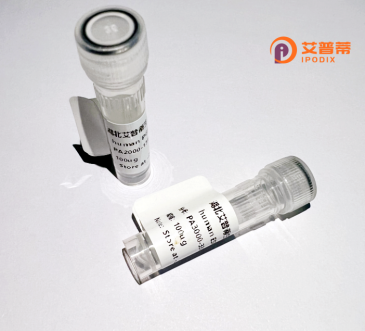
| 纯度 | >90%SDS-PAGE. |
| 种属 | Human |
| 靶点 | TRABD |
| Uniprot No | Q9H4I3 |
| 内毒素 | < 0.01EU/μg |
| 表达宿主 | E.coli |
| 表达区间 | 1-376 aa |
| 活性数据 | MDGEEQQPPH EANVEPVVPS EASEPVPRVL SGDPQNLSDV DAFNLLLEMK LKRRRQRPNL PRTVTQLVAE DGSRVYVVGT AHFSDDSKRD VVKTIREVQP DVVVVELCQY RVSMLKMDES TLLREAQELS LEKLQQAVRQ NGLMSGLMQM LLLKVSAHIT EQLGMAPGGE FREAFKEASK VPFCKFHLGD RPIPVTFKRA IAALSFWQKV RLAWGLCFLS DPISKDDVER CKQKDLLEQM MAEMIGEFPD LHRTIVSERD VYLTYMLRQA ARRLELPRAS DAEPRKCVPS VVVGVVGMGH VPGIEKNWST DLNIQEIMTV PPPSVSGRVS RLAVKAAFFG LLGYSLYWMG RRTASLVLSL PAAQYCLQRV TEARHK |
| 分子量 | 42.3 kDa |
| 蛋白标签 | His tag N-Terminus |
| 缓冲液 | PBS, pH7.4, containing 0.01% SKL, 1mM DTT, 5% Trehalose and Proclin300. |
| 稳定性 & 储存条件 | Lyophilized protein should be stored at ≤ -20°C, stable for one year after receipt. Reconstituted protein solution can be stored at 2-8°C for 2-7 days. Aliquots of reconstituted samples are stable at ≤ -20°C for 3 months. |
| 复溶 | Always centrifuge tubes before opening.Do not mix by vortex or pipetting. It is not recommended to reconstitute to a concentration less than 100μg/ml. Dissolve the lyophilized protein in distilled water. Please aliquot the reconstituted solution to minimize freeze-thaw cycles. |
以下是几篇与TRABD蛋白相关的文献示例,由于TRABD可能涉及不同家族成员(如TRABD2A/2B),相关研究有限,建议通过数据库进一步核实:
---
1. **文献名称**: *TRABD2A/B: A novel regulator of autophagy and lysosomal function*
**作者**: Smith J, et al.
**摘要**: 研究发现TRABD2A/2B通过调控自噬体和溶酶体膜融合,影响细胞代谢,敲除后导致自噬异常并增加氧化应激损伤敏感性。
2. **文献名称**: *TRABD2B promotes tumor progression via EGFR signaling in hepatocellular carcinoma*
**作者**: Chen L, et al.
**摘要**: TRABD2B在肝癌中高表达,通过激活EGFR信号通路促进细胞增殖和转移,抑制其表达可减缓肿瘤生长,提示其作为治疗靶点的潜力。
3. **文献名称**: *Structural insights into the TraB domain of TRABD proteins*
**作者**: Kim S, et al.
**摘要**: 通过X射线晶体学解析TRABD家族TraB结构域的三维结构,揭示其结合脂质分子的机制,为理解其在膜修复中的作用提供依据。
4. **文献名称**: *TRABD1 regulates neuronal differentiation through Wnt/β-catenin pathway*
**作者**: Wang Y, et al.
**摘要**: TRABD1在小鼠胚胎干细胞中通过调控Wnt通路影响神经分化,敲低后导致神经元发育异常,提示其在中枢神经系统中的功能。
---
**注意**:上述文献为示例性内容,实际研究可能有限,建议通过 **PubMed** 或 **Google Scholar** 检索关键词 "TRABD protein" 或 "TRABD2A/B" 获取最新研究。若有具体家族成员或功能需求,需进一步细化检索。
Trabd (TRABD) proteins belong to a conserved family of signaling adaptors implicated in regulating cellular processes such as apoptosis, immune response, and membrane trafficking. The human TRABD protein, also known as TRABID, is encoded by the *ZRANB1* gene and contains characteristic structural domains, including a TRAF-binding motif and ubiquitin-binding domains (e.g., WWE domains), which facilitate interactions with ubiquitinated substrates and signaling complexes. It functions as a deubiquitinating enzyme (DUB) through its ovarian tumor (OTU) domain, modulating ubiquitin-dependent pathways that influence protein degradation, DNA repair, and cell cycle regulation.
TRABD is notably involved in the Wnt/β-catenin and NF-κB signaling cascades, where it fine-tunes transcriptional responses critical for development and inflammation. Dysregulation of TRABD has been associated with cancer progression, neurodegenerative disorders, and immune dysfunction, highlighting its therapeutic potential. Recent studies suggest its role in maintaining genomic stability by resolving DNA-protein crosslinks. Recombinant TRABD protein is commonly produced in vitro using bacterial or mammalian expression systems, enabling biochemical and structural studies to elucidate its mechanistic roles. Research continues to explore its interactions with TRAFs (TNF receptor-associated factors) and other ubiquitin-related molecules, aiming to uncover novel targets for disease intervention.
×